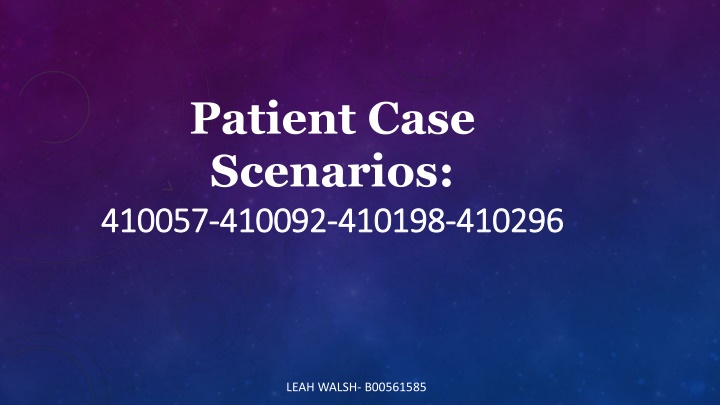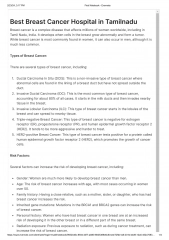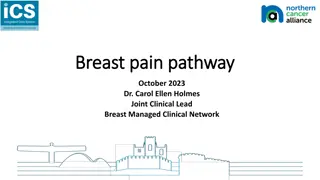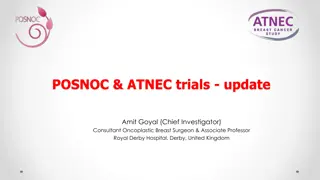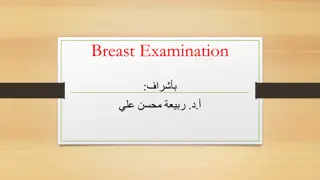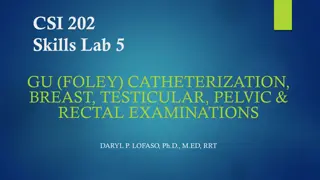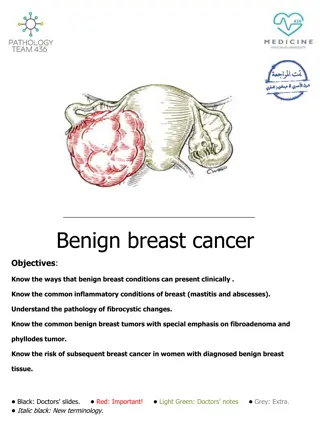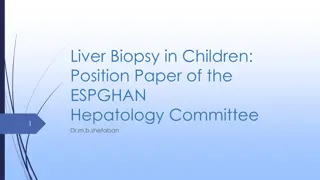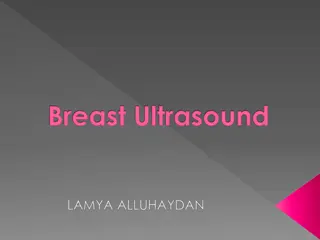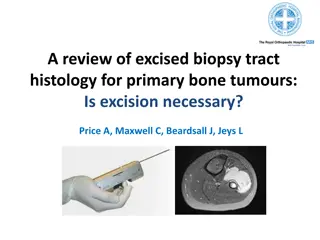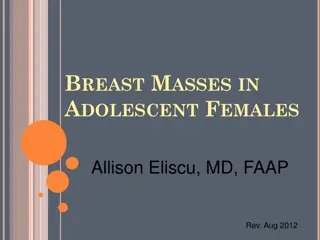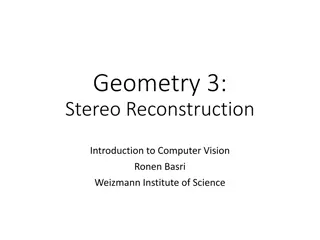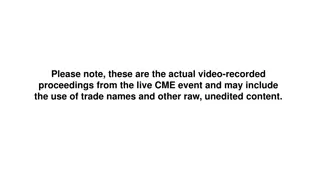Breast Reconstruction and Colonoscopy Biopsy Procedures
This text discusses a patient case involving breast reconstruction with a TRAM flap due to breast cancer spread, along with a colonoscopy biopsy for colonic polyps. Detailed coding and diagnosis information are provided, highlighting the challenges in the documentation of the patient's history and procedures.
Download Presentation

Please find below an Image/Link to download the presentation.
The content on the website is provided AS IS for your information and personal use only. It may not be sold, licensed, or shared on other websites without obtaining consent from the author.If you encounter any issues during the download, it is possible that the publisher has removed the file from their server.
You are allowed to download the files provided on this website for personal or commercial use, subject to the condition that they are used lawfully. All files are the property of their respective owners.
The content on the website is provided AS IS for your information and personal use only. It may not be sold, licensed, or shared on other websites without obtaining consent from the author.
E N D
Presentation Transcript
Patient Case Scenarios: 410057 410057- -410092 410092- -410198 410198- -410296 410296 LEAH WALSH- B00561585
PATIENT CASE: 410057 19367: Repair and/or reconstruction procedures on the breast. * Breast reconstruction with transverse rectus abdominis myocutaneous flap (TRAM), single pedicle, including closure. The TRAM flap uses the woman s own abdominal wall fat with a muscular pedicle. -I chose this code because the documentation states that when the surgeons got into the procedure fully they discovered that the cancer was not localized (in-situ) anymore and had spread throughout more breast tissue. They had to stop the procedure and speak with the patients husband and get consent to follow through with the alternate route that was discussed before surgery, which was removing the mass that had grown in a previous mastosplexy site as planned. C50.911: Malignant neoplasm of unspecified site of right female breast. * Newly diagnosed Stage IIa right breast invasive ductal carcinoma- ER/PR 99% Her 2Neu negative per IHC -I chose this as a primary diagnosis because the patient was fully diagnosed with staging and hormone receptions. L8000: Breast prosthesis, mastectomy bra, without integrated breast prosthesis form, any size, any type -I chose this code because the documentation stated Mastectomy bra in place. Additional Codes: E03.9: Hypothyroidism, unspecified. patient is on Levothyroxine as a daily medication Z85.3: Personal history of malignant neoplasm of the breast- the Stage IIa right breast cancer is the second time she has been diagnosed with breast cancer.
Patient 410057 When I first began reading this chart, I immediately noticed that the beginning of this patient s record is missing. The record starts almost in the middle of a specific diagnosis which was the Breast Carcinoma. Having more information from the initial findings of the first mass I feel would have made the case easier to follow and understand. I was having a hard time following which time she had breast augmentation for pleasure or if it was due to a carcinoma in the past. The documentation was not clear. If the physician that was currently working with the patient had pulled up her entire chart I think he would have seen that he would have known prior to his surgery that the carcinoma was no longer localized to the ducts but had spread to the surrounding breast tissue.
Patient Scenario: 410092 45380: Colonoscopy with biopsy, single or multiple, describes the use of forceps to grasp and remove a small piece of tissue without the application of cautery. The procedure note may describe the biopsy using cold biopsy forceps or may not mention the device at all. The biopsy may be from an obvious lesion that is too large to remove, from a suspicious area of abnormal mucosa, or from a lesion or polyp so small that it can be completely removed during the performance of the biopsy. *If a biopsy is performed on the same lesion that is removed only the code for the removal is reported. https://www.elitecme.com/resource-center/health-information-professionals/understanding-how-to-code-colonoscopies- 2 D12.2: Benign neoplasms of ascending colon *Documentation stated Large tubulovillos adenoma in ascending colon Z86.010: Personal history of colonic polyps *Documentation stated in the HPI, Multiple resected polyps diagnosed as tublovillous adenomas and tubular adenomas. https://www.hiacode.com/education/diagnosis-coding-colon-polyps-and-history-of-colon-polyps/ 81450: Under Genomic Sequencing Procedures and Other Molecular Multianalyte Assays *Documentation shows the Next Generation Sequencing (NGS) Molecular Report C18.8: Malignant neoplasm of overlapping sites of colon. * Documentation states on the NGS report Tumor characteristics: tumor type: colorectal adenocarcinoma; Tumor site: colorectal tumor; % In micro-dissected area: 30% E66: Obesity Personal History documented: Z86.2: Personal history of gestational diabetes Z86.79: Personal history of diseases of the circulatory system Z86.39: Personal history of other endocrine, nutritional and metabolic disease Z87.09: Personal history of other diseases of the respiratory system Z87.19: Personal history of other diseases of the digestive system
Patient 410092 The Assessment and Diagnosis stated: Large tubulovillosadenoma in ascending colon with partial resection ... Requires re-evaluation and possible EMR The notes also states the following: Considering the above evaluation, I believe this patient is an acceptable candidate for the procedure planned as outlined above. Although, the documentation states that the patient is an acceptable candidate for the procedure outlined in the report, it does not state any confirmation specifically. The report does give pathology findings from the procedure that was done. This patient documentation needs more operative documentation to help support its findings and reasoning for the NGS Molecular testing.
Patient Scenarios: 410198 11443: Excision, benign lesion, including margins, except skin tag (unless listed elsewhere, face, ears, eyelids, nose, lips, mucous membrane,; excised diameter 2.1-3.0cm. *Documentation stated the lesion was 1.5cm long by 0.5 cm wide. The excised diameter equals the length of the lesion at its longest point, plus two times the narrowest margin. For example, if the lesion measures 1 cm at its greatest, and the surgeon removes a margin of 0.5 cm on all sides, the total excised diameter is 2.0 cm (1.0 cm + [2 x 0.5 cm]). The total excised diameter is 1.5 cm (the lesion itself) plus twice the margin (2 x 0.5 cm = 1.0 cm), then take the original 1.5cm lesion+ 1.0 which includes the margins and that gives me the total of 2.5cm. 1.5+ (2 x 0.5)= 2.5cm L72.3-LT: Sebaceous Cyst https://www.aapc.com/blog/26192-skin-lesion-excision/ L98.8: Other specified disorders of the skin and subcutaneous tissue *Left cheek epidermal cyst Z86.39: personal history of other endocrine, nutritional and metabolic disease Z86.011: Personal history of benign neoplasm of the brain *Past medical history of pituitary adenoma Z83.3: Family History of Diabetes Mellitus Z80.3: Family history of malignant neoplasm of breast
Patient 410198 When reading the actual operative report where the patient name and date of service is blanked out, it has the pre-operative and post-operative diagnosis listed. The report also states the operation performed. The name of the surgeon is taken out and the type of anesthesia and the name of the anesthesiologist is left blank as well. These portions of the operative report being left blank can be cause for errors in coding for the following reasons. Was there only one surgeon on the case? Did the surgeon provide the anesthesiology? Was this the correct patient or the same patient that was from the above documentation. The pathology report on the last page states that the clinical history of a painful lesion on left side of face. All other documentation states that the lesion appeared from a prior excision of cyst. According to patient, the scar seems to be getting bigger, itchy, and sometimes drains foul smelling material. The patient did not state anything about pain. This is conflicting documentation.
Patient Scenarios: 410296 F79: Unspecified intellectual disabilities *Documentation states intellectual disability, unable to tolerate dental care. This documentation is the basis for the entire encounter. R56.9: Unspecified convulsions *Documentations states seizures . Z01.21: encounter for dental examination and cleaning with abnormal findings D0210 intraoral - complete series of radiographic images D2940x3: Protective restoration direct placement of a restorative material to protect tooth and/or tissue form. This procedure may be used to relieve pain, promote healing, and prevent further deterioration. Not to be used for endodontic access closure, and as a base liner under restoration https://www.dentaleconomics.com/practice/article/16388822/its-allinclusive Documentation states in the procedure that details the above. D3110: pulp cap - direct (excluding final restoration) *Documentation states retentive prep was completed on pulp canal and then restored with amalgam material. D0150 comprehensive oral evaluation - new or established patient https://www.deltadentalco.com/uploadedFiles/ProviderFeeSchedules/DDCO_Par_Provider_Documents/CDT%20 2017_Code%20on%20Dental%20Proc_Nomenclature%20online.pdf
Patient Scenarios 410296 On the patient discharge summary, the top right corner states that the patient is 45years of age. But the documentation states that Children may respond in quite different ways . This was the first part of documentation that didn t make sense. There should be discharge instructions for an adult not for a child. On the printed Operative report the pre-operative diagnosis and post-operative diagnosis is not listed. Even though it was listed on the hand-written history and physical Impression/Diagnosis but had not been updated on the Operative report. Within the operative report there were indications for the procedure in which stated the patient s developmental delays and medical necessity for nasotracheal intubation for dental examination.
References: 1. American Dental Association CDT-2017 Code on Dental Procedures and nomenclature effective January 1, 2017 https://www.deltadentalco.com/uploadedFiles/ProviderFeeSchedules/DDCO _Par_Provider_Documents/CDT%202017_Code%20on%20Dental%20Proc_Nom enclature%20online.pdf 2. AAPC, Skin Lesion Excision: Answer 3 Questions to code correctly: https://www.aapc.com/blog/26192-skin-lesion-excision/ 3. Advanced Clinic: Breast Surgery Clinic CPT Coding http://hcmarketplace.com/media/supplemental/2600_acmaterials.pdf 4. History of Colon Polyp Health Information Associates: Coding Tip: Diagnosis Coding-Coding Colon Polyp and https://www.hiacode.com/education/diagnosis-coding-colon-polyps-and- history-of-colon-polyps/ 5. ICD-Codes https://icd.codes/icd10cm/C188
Video and Voice Disclaimer I attempted to add voice and video to my PowerPoint, in which I have done before, and I know how to do. There is something wrong with my laptop and I cannot even click on the windows square in the bottom left-hand corner of my screen to restart my laptop to reboot it. I am also unable to even open the Microsoft 360 suite. I was only able to open up the PowerPoint application though opening up a prior PowerPoint that I had created for a previous class and then go to the file tab and drop down to new . It seems as if I only have permissions for certain things. When I open up file folder and try to click on the settings for the entire computer it will not allow me to open it, for example, I could not change the background of my laptop through the display settings because I cannot access that screen. I just wanted to make you aware that of why there is voice and video missing from the presentation. Leah Walsh
